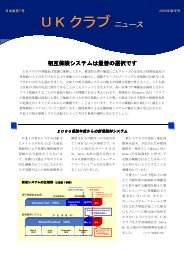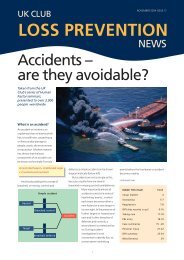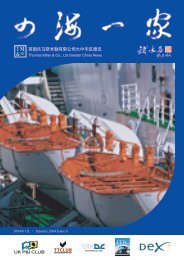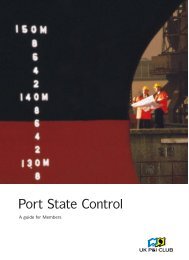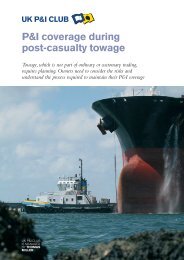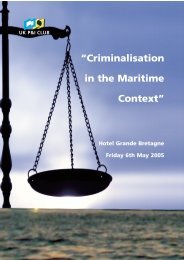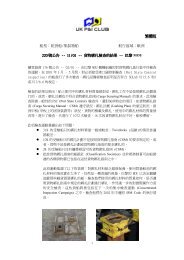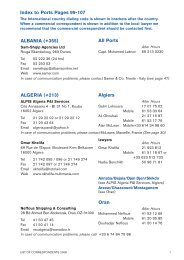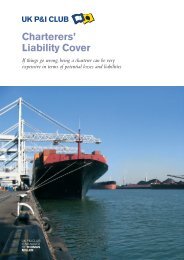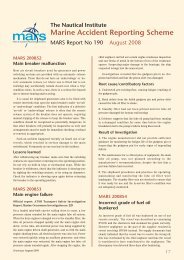Read full text
Read full text
Read full text
- No tags were found...
You also want an ePaper? Increase the reach of your titles
YUMPU automatically turns print PDFs into web optimized ePapers that Google loves.
CHAPTER 9ENTRIESTokyo
FROM the early years, ‘United Kingdom’ in the title of the club became less and less an accurate descriptionof the membership. As the books of entries pre-1926 were destroyed and 1885 is the first year for a complete runof rule books, in which lists of steamers were appended, it is impossible to give an accurate date for the first nonUK steamer to be entered. Certainly by 1876 the Katherina II, built in St Petersburg in 1874, appeared in the listof 418 vessels, along with two new-builds from Rotterdam. Two ships from Nantes, France were in by 1882. By1885 a Greek ship, Embiricos, was trading in the Black Sea, and among the 970 entries for that year there are shipsfrom Antwerp and Malmo. Constantinople, with the Thiresia, appears in the 1887 list of 860 vessels. By this timethe Low Countries, with 12 entries, were the best represented foreign interests in the club.Early overseas entries were mainly from Northern Europe, coming through geographical proximity and closetrading relationships with Britain. The notable exception was the Greeks from the Eastern Mediterranean.There the influence was cultural and hence deeper, growing in volume after World War I. Greek ships nowaccount for one-quarter of the tonnage entered in the club.Fotis Lykiardopulo, of a third generation in shipping, sketches the cultural background: The Greeks who wentinto shipping firstly knew something about the sea because we are surrounded by the sea but far more important than that,they were adventurous. Everybody was related. The captain was related to most of the crew. People behaved well becausethey were frightened what the head of the family, the captain, would report back in the village. There was a wonderful senseloyalty and discipline. It was hard work and a hard life. It was not common to all Greeks. They went and worked in shipsand got shares with family help. They got their master’s certificate. When they went abroad and opened a small office orworked in an office abroad, the first thing was to bring their families there. It sprang up with no help whatsoever from theGreek government. That has always applied to Greek shipping. We have no help in terms of finance. We have to do all thisourselves. Our own country is too poor to offer it to us or to support us in any way. So individuality is the key work of gettingup, taking risks and discomfort and leaving your family, going to sea to work, going ashore. A lot of them deserted ashorebecause they could not get visas to go there, and started up abroad. When they brought some for their families, some becamedishwashers when they arrived, but always it was this desire to improve oneself. Miles Kulukundis sketches his familyexample: We have been shipowners for some 200 years. They were seafarers because the islands did not support them. Theyhad to look to the sea. Fishing was the first step and then trading. Trading in the Mediterranean was an industry for 2,000years or more. My direct grandfather lived on the Island of Kasos and half of his family was born there. He was a ship’smaster and they moved from Kasos to Thira, which was the coaling station and probably the major port of Greece in about1900. Then in 1919 one of my great-uncles had the view that if you were going to be in the mainstream of the shippingindustry he had to come to London, and set up Rethymnis &. Kulukundis as an agency.Examples could be multiplied into a composite portrait of a Greek shipowner. Be he an owner-master plyingthe Aegean or an expatriate in Monaco or New York overseeing an international tanker fleet, the attitude andpattern of progress are similar. An element in securing that progress is protecting the assets and insuring againstruinous liabilities. Soon after opening in 1921 an office for Rethymnis & Kulukundis in the City of London, thecentre of chartering and insurance, Manuel Kulukundis, uncle of Miles, called on Dawson Miller and offered toput ships in the club. Other firms followed as lower-cost Greek shipping re-established itself in the difficult conditionsof the early 1920s. Currently, the UK Club covers some 40 per cent of the beneficially owned Greek merchantfleet.The circumstances in which nations entered the club varied. Cultural backgrounds, the political stance ofregimes, pressing practical considerations, the meeting and meshing of personalities all played a part.Introducing the P & I concept was not the application of a formula; the approach had to be individual.
major tanker fleets - Novorossiysk, Latvian, Georgian and Primorsk Shipping Companies - were entered in theclub by way of a reinsurance of Ingosstrakh, the state insurance organisation. Acting largely on their own initiative,from the mid-1960s a number of Eastern Bloc countries, notably Bulgaria, East Germany, Estonia andRomania came into the club.The entry of the other great Communist power, China, is a similar, later story, starting in 1973. Chinese shipsat the time were either uninsured or had a limited cover from the People’s Insurance Company of China inBeijing. As a consequence shipping companies were finding that they had not got the insurance necessary tocover their TOVALOP pollution liabilities. They were not able to charter their ships to oil companies, whowould demand insurance against TOVALOP liabilities and so in 1973 the People’s Insurance Company inviteddelegates from the UK Club managers to meet them in Beijing to see whether the entry of certain tankers couldbe negotiated.Terence Coghlin was one of the delegates: I set out with Sidney Fowler and with William Richards, an averageadjuster who had been to Beijing before. Our train from Hong Kong stopped at the border river. After we had crossed overthe bridge into the People’s Republic, we were given a deliberately chilling reception by the Chinese border guards. Our passportswere taken away and we were left to cool our heels for some considerable time, without explanation, in an unfurnishedbarrack like building. Upon our release we at once experienced the contrast between official and private China. We werewarmly greeted by three charming people from the local branch if the People’s Insurance Company (PICC). Over the nextfew days they showed us Guangzhou. We visited schools and factories and stood ankle deep in a collective farm’s paddyfield, helping to harvest rice. Everywhere we went we were lectured about the wicked way of the West in general and theAmericans in particular and assured that Chairman Mao’s thoughts would conquer the world. We sat quietly and held ourlittle red books reverently. On page 233 of the little red book, Quotations from Chairman Mao Tse Tung, there wasample justification for the whole exercise in an extract from Oppose Book Worship (1930): You can’t solve a problem?Well, get down and investigate the present facts and its past history! When you have investigated the problem thoroughly,you will know how to solve it. Conclusions invariably come after investigation, and not before. Only a blockheadcudgels his brains on his own, or together with a group, to ‘find a solution’ or ‘evolve an idea’ without making any investigation.It must be stressed that this cannot possibly lead to any effective solution or any good idea.Terence Coghlin continues: Thus initiated we were allowed to travel on to Beijing and visit the head offices of boththe PICC and of China Ocean Shipping Company (COSCO). After further days of sightseeing - most notably the GreatWall and the adjacent Ming Tombs - our hosts at last felt it appropriate to mention business and we arranged the entrythrough PICC of several COSCO tankers. The Chinese were also quick to benefit, as Luke <strong>Read</strong>man records: Inthe first year of their entry, before any of the other branches had entered their ships, the Tianjin Branch had a total loss withthe Ying Shan caught in a typhoon of Japan. That produced a big wreck removal problem. So their record started with quitea substantial bang and it was indeed a pool claim by the time we had paid for the wreck removal and solved the variousother problems such as the cargo. That was certainly the most important claim that affected a Chinese shipowner for manyyears. The news if that would have spread within the Chinese shipping community. Of course it did affect the rate that weneeded for the renewal of that fleet and we started even at that stage the differentiation between the rates payable by differentbranch companies of COSCO. Each one from the earliest times has kept its individual record and its individual rate,depending on its own claims record.Over in Japan the history of P & I is older. In 1908 Professor S. Tasaki of Nagasaki High Commercial Collegereported on the subject after learning about it in London from the managers of the UK Club. Later he becamepresident of Kobe University and, under his guidance, the appropriate law was enacted and a Japanese P & I clubestablished in Kobe in 1950. At first, as part of the post-war reconstruction of Japan, Frank Ledwith and then
Motohiro Sugiura, general manager ofInchcape P & I (formerly Dodwell), the club’scorrespondents in Japanhe and Sidney Fowler, ‘typically’ English gentlemen withbowler hats and rolled umbrellas, augmented by Sidney witha large white handkerchief which he plucked from his sleevewith a flourish, freely gave advice with no strings attached.The first Japanese entry in the club, reinsurance fromAmerican International Underwriters, was Tokyo Tanker in1956.In the mid-I960s the Japanese club ran into difficultiesover indemnity cover, essentially cargo liability risks, andwithdrew from that class of business. The UK Club wasasked to fill the gap. It already had a correspondent establishedin Japan. Naga Kotsuru of Dodwell & Co. Draws thestrands together: When in the late 1950s there was heavy congestionat Japanese ports, Dodwell Tramp Agencies assisted theshipowners in collecting demurrage from local charterers. This wasvery much appreciated by the owners, mostly Greek, and theirLondon solicitors, Richards Butler. The solicitors recommended tothe UK Club that Dodwell & Co. should become its correspondent.Kim Saishoji, then general manager of Dodwell Tramp Agencies, was trained by the UK Club in London for three months,and after his return to Tokyo in 1957 he set up a small P & I office, within the Tramp Agencies department staffed by himself.Shortly afterwards he recruited a college graduate, Moto Sugiura, to join them. Moto Sugiura continues the story:Kim and Sidney Fowler concentrated their efforts to make sure NYK management <strong>full</strong>y understood P & I insurance andthe advantages of their entering in the UK Club. Final confirmation to cover indemnity risks with the club was notified toSidney, who had been staying in Tokyo from earlyDecember 1965, on his third visit to Japan, on 27December. As this was the first entry materialised by himin Japan he remained here until NYK obtained approvalfrom the Ministry of Finance, which is required under thelaw concerning foreign insurers, sacrificing his happyChristmas holidays with his family and returned homeafter 1966 began. Soon after NYK entered the club, in1968 Mr Y. Ariyoshi, who held an honorary Britishknighthood for services to Anglo-Japanese shipping,became a director of the club. A number of otherJapanese shipping companies followed, among themMitsui OSK Lines, many of them placing theirindemnity risks with the UK Club, leaving their protectioncover with the Japanese club, which subsequentlyre-entered the market for indemnity.A by-product of entry to the Japanese market wasthe opening of Korea. Peter Tallis, the underwriterspecialising in Japan, first visited Seoul in 1968 withNaga Kotsuru, who enlisted the help of HyopsungMr Y. Ariyoshi, the first UK Club director from Japan from1969 to 1979, president of Nippon Yusen Kaisha from1965 to 1971, and chairman from 1971 to 1978
Shipping Corporation, Dodwell’s sub-agents in Korea. Senior shipowners spoke Japanese, which helped theP & I concept to spread quickly. There were also no such restrictions concerning foreign insurers as those underJapanese law.T.E. Wang, president of Hyopsung Shipping, looks back on a growth market: The rapid double-digit growth ofthe Korean economy and trade since the 1970s has encouraged Korean shipping companies to expand rapidly their .flag tonnage.The Korean fleet grew from some 800,000 grt in 1970 to 4 million grt in 1980. The annual average growth rate of17 per cent was accomplished by importing second-hand ships and by building new ships. Although the growth rate after1980 decreased because of the damage caused by the world shipping depression, the Korea fleet increased to approximately9 million tons including bare boat chartered ships at the end of 1994. Every Korean owner appreciates he can no longeroperate his fleet without the proper services rendered by P & I clubs.Meanwhile, Luke <strong>Read</strong>man was having to deal with Japanese restrictions: lt was apparent in the late 1970s thatthe club might at some stage need to have a licence from the Japanese government to insure Japanese flag ships whether forindemnity risks or protecting risks. An approach was made to the Ministry of Finance on a fairly informal basis, stating theclub’s position and asking to discuss an application for a licence as a foreign insurer in Japan. That discussion was held upby the Ministry of Finance for approximately 12 years. They said they would need to consider it and study it very care<strong>full</strong>y,and almost nothing happened. Eventually in the late 1980s two things came together. One was the great liberalizationof Japanese financial markets, including insurance and the possibility that a foreign insurer’s licence would now be moreeasily obtainable. The second thing was the growth and strength of the Japan P & I Club and its desire to become a directmember of the pool rather than relying on reinsurance, which had traditionally been given to it by the Britannia Club andthe UK Club. Those two threads came together and in the late 1980s the UK Club applied formally for a licence to do businessas a foreign insurer in Japan, that isto insure Japanese flag ships for protectionand indemnity risks in Japan. It was aninteresting and difficult task to completeall the necessary formalities for theMinistry of Finance because the foreigninsurers’ laws written in 1950 had notchanged. All the regulations issued underthat law were all naturally geared to commercialinsurance companies, and in thenumerous questionnaires and applicationdocuments that we had to fill out many ofthe questions were just not applicable to amutual club. We had to get ourselves in aposition where we could answer ‘Yes’ toall the relevant questions on the form, eventhough we believed that they were eithernot important questions or positively inapplicablequestions. That resulted in theclub having its only branch office anywherein the world, namely Tokyo, andthe appointment of Mr Hojo as the club’sJapanese representative. Finally, we wereThe UK Club Japan Branch opened in 1989. The Japanrepresentative, Mr M. Hojo, and his staff are the only employees ofthe UK Club anywhere in the world
The Hanjin Osaka, built in 1992, can carry 4,024 TEU containers
successful, the licence being granted at a formal ceremony in May 1989. The UK Club’s Japan branch started doingbusiness a month later.In Sweden there was also the problem of competing with a well-established local club, described by RexPalmer: Historically, Scandinavian shipowners much preferred to place all their marine insurances through one company.They did not like to have to go to a hull underwriter in one direction and quite another direction for P & I. So the Swedishclub in particular was very difficult to compete with because it had both facilities. We therefore came to an arrangement witha big Swedish insurance company with strong lines in hull and cargo business, Hansa, and through them in 1954 set up acompany called Indemnitas.Actively to do business in Sweden as a foreign insurer required a licence, and we could obtain that licence with the helpof Hansa. As a domestic insurer, they could guarantee to the Swedish authorities the required level of solvency of the club.It cost no money to obtain the licence under that arrangement. Indemnitas became the fronting office for the UK Club inSweden. Swedish shipowners could go to Indemnitas to place their P & I with the UK Club. If they were interested in hullinsurance also they could be channelled to Hansa and vice versa.The other Scandinavian country in which the club has had an enduring involvement is Finland, where thedirectly entered tonnage, some of it pre-dating World War I, was supplemented from 1951 with reinsurance contracts.Business in Denmark and Norway, where there was an exceptional brief boom during the 1960s throughthe individual efforts of John Shearer, has not been significant. The two local clubs, Gard and Skuld, are wellestablished there.A nation that might have been expected to develop a P & I business of its own was France, which had centralisedinterests in Africa, Asia and the Middle East. Although the need was there, perhaps one of the main reasonsit could not be fulfilled was the French form of mutual, which could only exist and act according to a setof strict regulations. It lacked the pragmatic Anglo-Saxon approach. As early as 1882 the Grande CompagnieReinsurances proposed entering a large fleet of steamers with the UK Club but the proposal seems to havefoundered on the impossibility of obtaining a London bankers’ guarantee for the payment of calls.Not until 1926 was the first French fleet, that of grain shippers Louis Dreyfus, entered. This was followedby the wartime entry, in late 1943, of some Free French ships. The major influx took place from 1952, primarilyas a result of a decision by the Cour de Cassation on the Lamoricière, which opened up the possibility of unlimitedliability on shipowners, cover for which was not available from French insurance companies. A more recentappeal of the club is oil pollution cover, the Brittany coast being particularly vulnerable, as was demonstrated in1978 when the Amoco Cadiz (entered in the London Club) lost her steering and was driven on to rocks, broke upand spilled 230,000 tons of crude oil on to the region’s beaches and rich fishing grounds. That led to the formationof a clean-up group, Mission de la Mer, which helped Morocco in 1990 when its coast was threatened fromthe damaged Iranian tanker Khark 5.Beneath national and cultural differences, shipowners’ experiences and priorities, successful P & I comedown to the chemistry of individuals developing a bond. During World War I, in the battle of the Dogger Bank,John Essberger commanded a German cruiser and Dawson Miller a British destroyer, on which an experimentalsix-inch gun was mounted. The Germans got a nasty surprise when their cruiser was fired on with a six-inchshell, while the British, out-gunned and out-ranged, thought discretion the better part of valour and retreated.The Germans, thinking this manoeuvre was to lure them into a trap, did likewise. Nobody was injured in theskirmish. After the war, when the two men met and realised they had faced one another at sea, Essberger toldDawson how unsporting a six-inch gun was on a destroyer and entered his own ships. The relationship so forged
etween the two men lasted for the rest of their lives. Sport was also a great bond. In Croatia, before WorldWar II, Dawson Miller discovered a mutual interest in horse racing with the Ivanovic family from Dubrovnik,which led to a fleet entry. Members from many countries enjoyed his Derby Day parties. Such events helped tostrengthen a network of friends, reinforced by a group of correspondents, whose communications kept people intouch.




